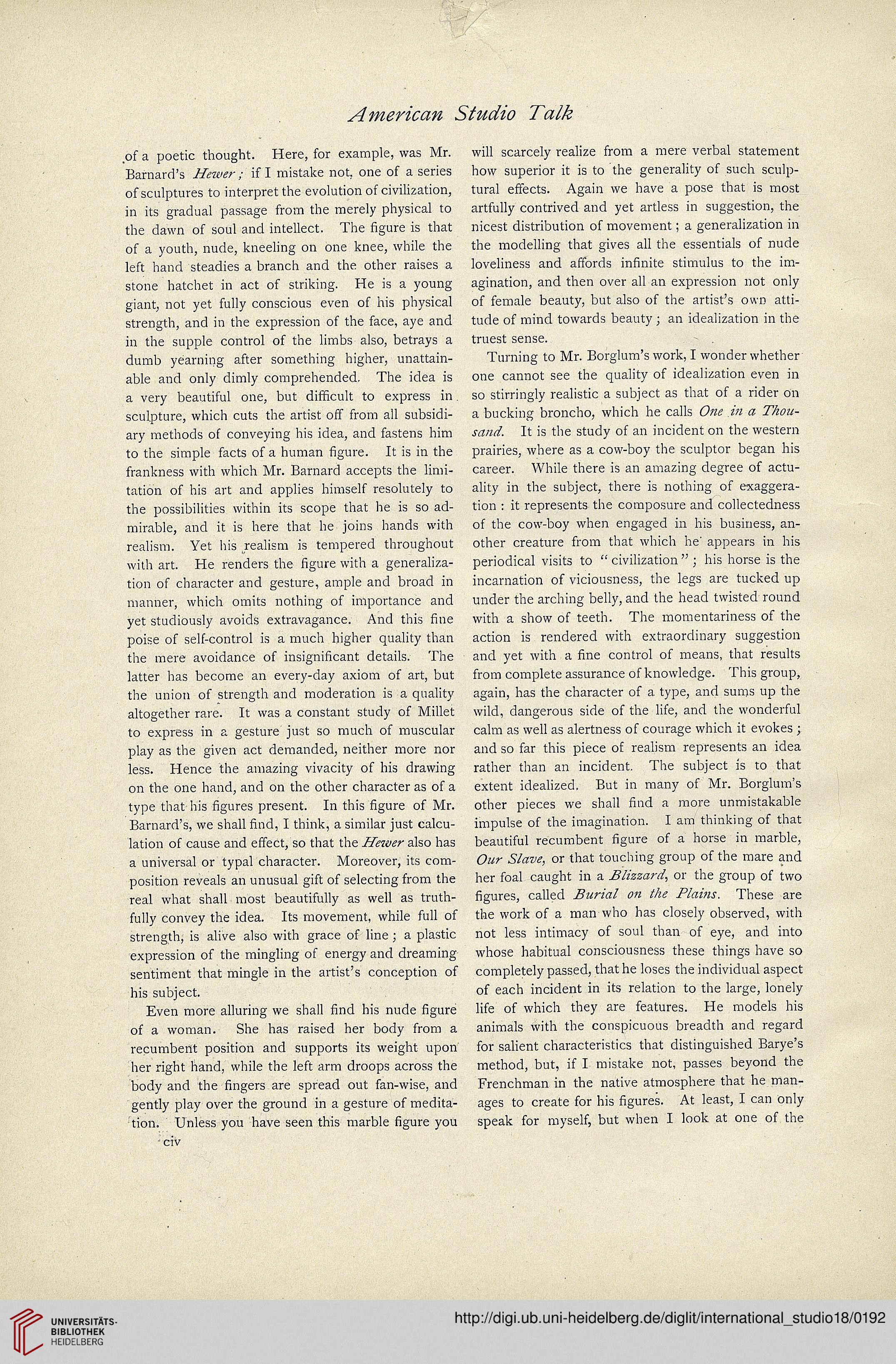of a poetic thought. Here, for example, was Mr.
Barnard's if I mistake not, one of a series
of scuiptures to interpret the evoiution of civiiization,
in its graduai passage from the mereiy physicai to
the dawn of soui and inteiiect. The figure is that
of a youth, nude, kneeiing on one knee, whiie the
ieft hand steadies a branch and the other raises a
stone hatchet in act of striking. He is a young
giant, not yet fuiiy conscious even of his physicai
strength, and in the expression of the face, aye and
in the supple controi of the limbs aiso, betrays a
dumb yearning after something higher, unattain-
abie and oniy dinriy comprehended. The idea is
a very beautifui one, but difhcult to express in
scuipture, which cuts the artist off from aii subsidi-
ary methods of conveying his idea, and fastens him
to the simpie facts of a human figure. It is in the
frankness with which Mr. Barnard accepts the limi-
tation of his art and applies himseif resolutely to
the possibiiities within its scope that he is so ad-
mirabie, and it is here that he joins hands with
realism. Yet his realism is tempered throughout
with art. He renders the figure with a generaliza-
tion of character and gesture, ample and broad in
matiner, which omits nothing of importance and
yet studiousiy avoids extravagance. And this fine
poise of self-controi is a much higher quality than
the mere avoidance of insignihcant details. The
latter has become an every-day axiom of art, but
the union of strength and moderation is a quality
altogether rare. It was a constant study of Millet
to express in a gesture just so nmch of muscuiar
play as the given act demanded, neither more nor
less. Hence the amazing vivacity of his drawing
on the one hand, and on the other character as of a
type that his frgures present. In this figure of Mr.
Barnard's, we shall find, I think, a simiiar just calcu-
lation of cause and effect, so that the ZT/TWT* also has
a universal or typal character. Moreover, its com-
position reveals an unusual gift of seiecting from the
real what shall most beautifuliy as well as truth-
fuiiy convey the idea. Its movement, while fuii of
strength, is alive also with grace of line ; a plastic
expression of the mingling of energy and dreaming
sentiment that mingle in the artist's conception of
his subject.
Even more aliuring we shaii find his nude figure
of a wornan. She has raised her body from a
recumbent position and supports its weight upon
her right hand, whiie the ieft arm droops across the
body and the fingers are spread out fan-wise, and
gently play over the ground in a gesture of medita-
tion. Uniess you have seen this marbie figure vou
wiii scarcely realize from a mere verbal statement
how superior it is to the generaiity of such scuip-
tural effects. Again we have a pose that is most
artfuliy contrived and yet artiess in suggestion, the
nicest distribution of movement; a generalization in
the modeliing that gives all the essentials of nude
loveliness and affords infinite stimulus to the im-
agination, and then over aii an expression not only
of female beauty, but also of the artist's own atti-
tude of mind towards beauty ; an ideaiization in the
truest sense.
Turning to Mr. Borglum's work, I wonder whether
one cannot see the quaiity of ideaiization even in
so stirringly realistic a subject as that of a rider on
a bucking broncho, which he cails Ow pv %
It is the study of an incident on the western
prairies, where as a cow-boy the scuiptor began his
career. While there is an amazing degree of actu-
ality in the subject, there is nothing of exaggera-
tion : it represents the composure and coiiectedness
of the cow-boy when engaged in his business, an-
other creature frorn that which he' appears in his
periodical visits to " civiiization " ; his horse is the
incarnation of viciousness, the legs are tucked up
under the arching belly, and the head twisted round
with a show of teeth. The momentariness of the
action is rendered with extraordinary suggestion
and yet with a fine control of means, that resuits
frorn complete assurance of knowledge. This group,
again, has the character of a type, and sutns up the
wiid, dangerous side of the life, and the wonderful
calm as well as alertness of courage which it evokes ;
and so far this piece of realism represents an idea
rather than an incident. The subject is to that
extent idealized. But in many of Mr. Borglum's
other pieces we shall find a more unmistakable
impulse of the imagination. I am thinking of that
beautiful recumbent hgure of a horse in marble,
AVrw, or that touching group of the rnare and
her foal caught in a Y?//32<77-Y, or the group of two
figures, called <777 Y%M7/.s'. These are
the work of a man who has closely observed, with
not less intimacy of soul than of eye, and into
whose habitual consciousness these things have so
completely passed, that he loses the individual aspect
of each incident in its relation to the large, lonely
life of which they are features. He models his
animals with the conspicuous breadth and regard
for salient characteristics that distinguished Barye's
method, but, if I mistake not, passes beyond the
Frenchman in the native atmosphere that he man-
ages to create for his hgures. At least, I can only
speak for myself, but when I look at one of t'ne
civ




